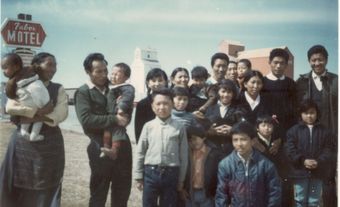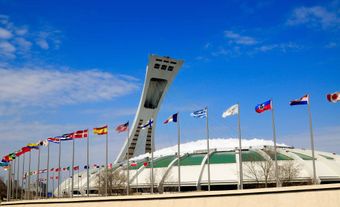
Mount Everest Expedition
The highest mountain in the world at 8847.7 m, Mount Everest lies on the border between Nepal and Tibet. It was first climbed in 1953 by New Zealander Edmund Hillary and Sherpa Tenzing Norgay. Since that time, Everest has been attempted by mountaineers from many nations. In 1982 the Canadian Mount Everest Expedition took up the challenge, under the sponsorship of Air Canada. The team consisted of 20 Canadians, under Bill March of Calgary, and 39 Nepalese Sherpas.
Preparations for the climb took 5 years and involved over 100 Canadian companies, who provided nearly 20 tonnes of equipment and food. Special equipment had to be designed and manufactured, including tents made of "bulletproof" nylon. Over 6000 man-days of food was packed in Canada into daily ration boxes for carrying up the mountain. In addition, preparations were made to send TV signals back to Canada using 3 satellites. (This was the first "live" TV coverage of an Everest expedition.) After a 240 km hike from Katmandu, capital city of Nepal, the expedition arrived at the base of Everest on 15 August 1982. Over the next 2 weeks rapid progress was made through the terrifying Icefall and into the Western Cwm ("valley"). By the end of August the route had been pioneered to Camp 2 at 6545 m. However, on August 31 tragedy struck when a huge avalanche fell across the route in the Icefall, killing 3 Sherpas. Two days later a collapsing ice tower killed cameraman Blair Griffiths.
This double blow stopped the expedition, sending half the team home, and it was 2 weeks before the climb could proceed. On September 22 the climbers established Camp 2 and started work on the upper mountain. Camp 3 was established at 7155 m, and on October 4 the final Camp 4 was occupied on the South Col at 7980 m. On October 5 the first summit team of 32-year-old Laurie Skreslet of Calgary and Sherpas Sungdare and Lhakpa Dorje left the South Col camp at 4 AM and reached the summit at 9:15 AM after a rapid ascent. Two days later, the summit was reached a second time by 29-year-old Pat Morrow of Kimberley, BC, and Sherpas Pema Dorje and Lhakpa Tshering. The Canadian expedition thus placed 2 Canadians and 4 Sherpas on the summit of Everest on its first attempt in a year marked by very bad weather.

 Share on Facebook
Share on Facebook Share on X
Share on X Share by Email
Share by Email Share on Google Classroom
Share on Google Classroom



